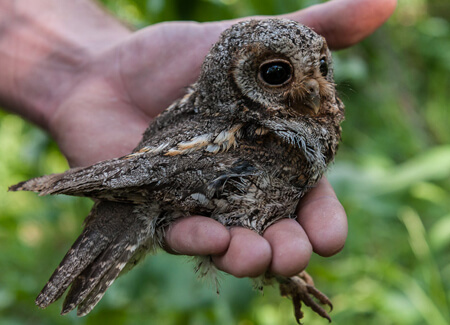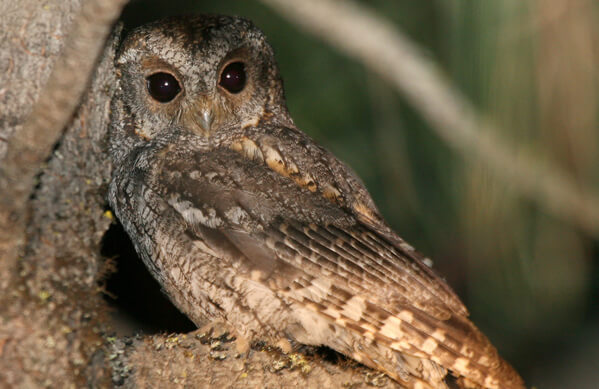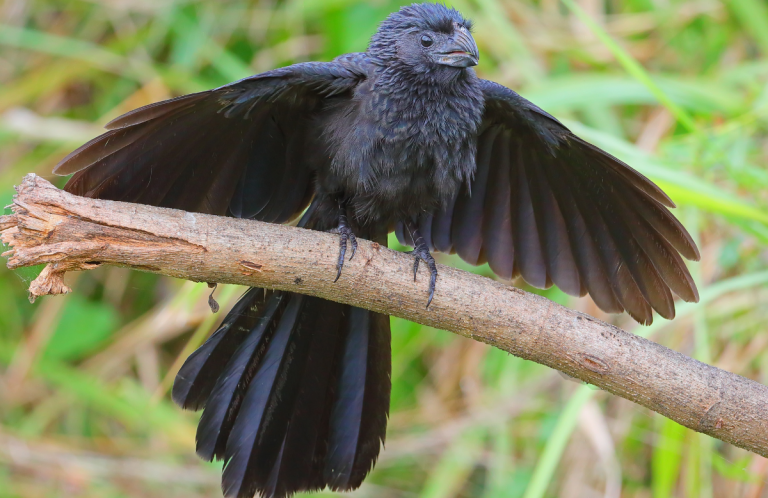 The “Flammie” is one of the smallest owls in North America, about the size of an American Robin. It is one of the few owls on the continent with dark eyes (others include Spotted and Barred Owls) and has short, feathered ear tufts. It's also one of the few migratory owl species in North America.
The “Flammie” is one of the smallest owls in North America, about the size of an American Robin. It is one of the few owls on the continent with dark eyes (others include Spotted and Barred Owls) and has short, feathered ear tufts. It's also one of the few migratory owl species in North America.
"Flammulated" means flame-colored; it refers to the streak of reddish feathers along this owl's shoulder and onto its back. This "flaming" streak gives this bird its Latin and common name.
Habitat loss is the biggest threat to Flammulated Owls — particularly the loss of nesting cavities, which can happen when snags are removed during timber harvest operations. The species is also vulnerable to pesticide over-use on its Central American wintering range.
The Flammulated Owl's call, a deep, usually single “hoot,” sounds a bit like someone blowing across the top of a bottle.
Hidden in Plain Sight
Once considered rare, Flammulated Owls are actually common in scattered locations across their range. However, they can be hard to detect and are most reliably identified by their voice.
These little owls occur in two color morphs, rusty-red and gray. Both colors are mottled with streaks, lines, and spots that provide effective camouflage against pine trunks, where the owls tend to perch during the daytime.
Like many birds of prey — such as the Bald Eagle — Flammulated Owls exhibit sexual dimorphism, with females generally growing larger than males.
Sign up for ABC's eNews to learn how you can help protect birds
Hunter of Insects
These small owls are insectivorous, preying almost entirely on moths, crickets, and beetles. They hunt by sitting quietly on a perch, then swooping down to grab their prey. (“Nocturnal flycatcher” is one way to describe this owl's unusual hunting habits.)
This dependence on insects may explain this bird's migration. Flammulated Owls that nest in North America retreat to southern parts of the species' range, as far south as Guatemala and El Salvador, in the winter.

Flammie in hand by Steve Joyce
In a Snag
Flammulated Owls generally nest in old woodpecker holes or cavities in dead trees, but they will use nest boxes where provided. The species has one of the lowest reproductive rates of North American owls, which may limit its population size.
Unusual for owls, this species seems to be somewhat colonial. The birds congregate in breeding populations limited to one area, even when other suitable areas are nearby.
Working in the West
Over the last 10 years, ABC has been working with land trusts in Oregon, Washington, Montana, and Idaho, making significant investments to restore habitat for Flammulated Owl, along with Lewis's Woodpecker and Williamson's Sapsucker.
Check out our publications to help landowners conserve habitat for cavity-nesting birds throughout the West, and specifically in the Pacific Northwest.
Want to help us conserve Flammulated Owls and other birds? Make a donation today!



















































